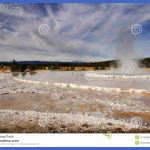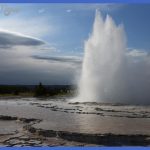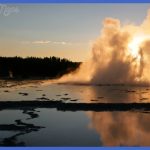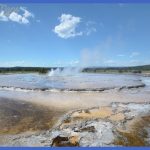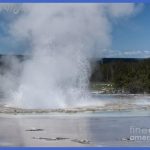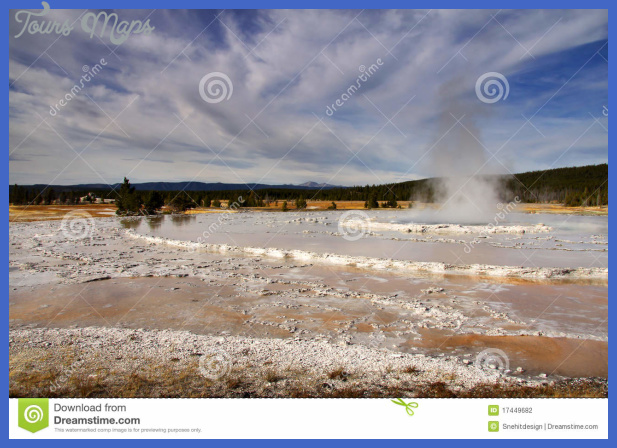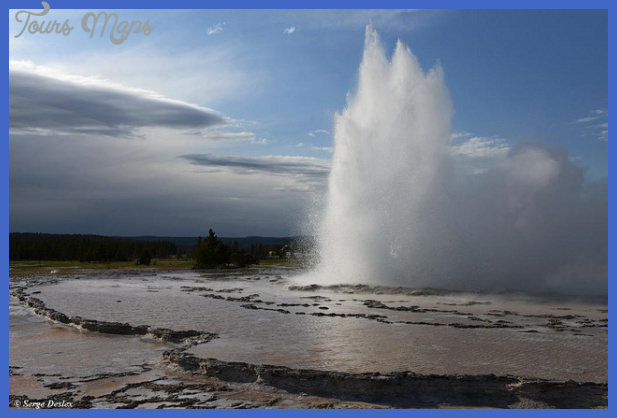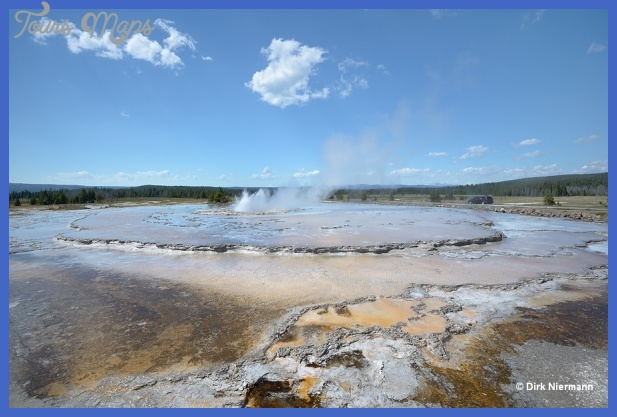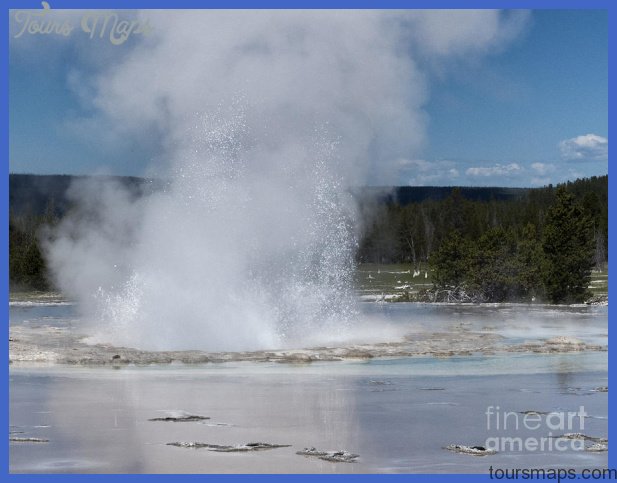NOTE: The mileage from the beginning of this side road is given in parentheses. Grand Loop Road mileage continues where Firehole Lake Drive rejoins it. © All thermal features are accessible tance is 10,336-foot (3150 m) Mount 8.2/8.8 Ha©(2) Fountain Paint Pot. Closest parking area entrance for those heading north. 9.0/8.0 White Creek crossing; Firehole Lake Drive begins. This side road runs one way south to north along this drive. (0.0) The dead pines standing in this marshy area have white socks, a result of absorbing silica from the hot spring runoff water surrounding their roots. You can tell that many mature trees were killed when thermal runoff switched direction to flow toward them. Unlike the lodgepoles killed by fire, most of these dead trees continue to stand for decades.
(0.65) Broken Egg Spring resembles an upturned egg with the shell broken off. (0.8) Firehole Spring is actually a perpetual spouter rather than a spring. In 1888, George L. Henderson, a tour guide and the namer of many Yellowstone features, wrote: Every few seconds there arise great globes that seem to revolve like chariot wheels as they rise toward the surface. Then they come faster and faster until they seem to glide into each other and rise into one magnificent dome of liquid splendor. . . . The runoff channels are lined with some of the park’s most beautiful, many-colored bacteria (see picture, 66). When you look northward, the beautiful mountain you see in the dis Holmes. William H. Holmes (18461933) was an artist and geologist who climbed this mountain as a member of the 1878 Hayden Geological Survey, a government-sponsored expedition. In his later years, Holmes was most noted for his work in American archaeology. (0.9) Surprise Pool is a deep black not blue pool (for the reason, see Black Water and Travertine, later in this section). An 1895 observer wrote, If a handful of gravel is thrown into it, it will bubble and sparkle, exactly like bro-mo seltzer. The modern visitor would substitute Alka-Seltzer. You could stir the water with a stick for the same result.
Please remember that throwing anything into a thermal feature not only destroys its beauty but is illegal. The phenomenon happens because any disturbance causes a bubbling reaction in superheated water, that is, water whose temperature is hotter than the boiling point. The group ofhot springs along White Creek across the road from Surprise Pool is named for the sinter deposits all along its length. Geologists have found that no cold water flows into White Creek, because any rain or groundwater must percolate through hot ground before reaching the stream. You can reach the White Creek hot springs group by a narrow trail leading up from the Great Fountain Geyser parking area. Octopus Spring, near the tree line, is a particularly beautiful pool. Its runoff channel has delicate pink filamentous bacteria (Thermocrinis ruber) growing at about 176°F (80°C). To impress your friends, tell them that the name Botryoidal Spring (pronounced bah-tree-OY-dul) comes from the Greek word for a cluster of grapes.
It’s a frequently bursting geyser that erupts with unusual masses of bubbles. DNA Fingerprinting Started Here! A team of biologists led by Dr. Thomas Brock found an extremely important thermophilic, or heat-loving, bacterium in a hot spring near here in 1965. The bacterium is Thermus aquaticus. An enzyme called Taq polymerase derived from this bacterium has contributed to medical diagnosis and to DNA fingerprinting. This enzyme is useful specifically because of its unusually high heat stability. Now many researchers are bioprospecting throughout Yellowstone’s hydrothermal areas for other thermophiles that may prove useful or even help to solve the mystery of the origin of life on earth. (1.0) I) Great Fountain Geyser ranks today as one of the four highest-spouting active geysers in Yellowstone and in the world. While eruptions of the others Steamboat Geyser at Norris Geyser Basin and Giant and Beehive geysers at Upper Geyser Basin are unpredictable, Great Fountain is fortunately quite predictable. Eruptions usually range between 100 and 150 feet (30-45 m) high, but may go higher in an occasional superburst. The average interval between eruptions is now about 12 hours.
The next Great Fountain Geyser erupts straight into the air predicted eruption time is usually listed at Old Faithful Visitor Center as well as at the geyser. Although there may sometimes be a shortage of park rangers to write the predicted range of times on the signboard, a knowledgeable geyser gazer is often on hand to predict the next eruption, using a formula based on the duration of the previous eruption. She or he can refine the prediction after noting the length of time water overflows from the central vent. The eruption usually starts more than an hour after overflow begins. Your patience will be amply rewarded by a spectacular eruption! The beginnings of some bursts are accompanied by a so-called blue bubble at the base of the water column. Don’t be in a hurry to leave wonderful bursts may erupt from a seemingly empty crater during the next hour. Even the crater of Great Fountain is impressive, with a vent 16 feet (4.8 m) across surrounded by concentric rings of geyserite that extend to about 150 feet (45 m) in diameter. Its symmetry so impressed expedition leader Ferdinand V. Hayden in 1871 that he called this geyser Architectural Fountain. This is perhaps the park’s largest fountain-type geyser. Such geysers have a very broad pool rather than a cone or narrow vent, and they usually erupt in successively larger spurts, sometimes beginning with a dome-shaped surge.
Great Fountain Geyser Photo Gallery
Maybe You Like Them Too
- The Best Cities To Visit in The World
- World’s 10 Best Places To Visit
- Coolest Countries in the World to Visit
- Travel to Santorini, Greece
- Map of Barbados – Holiday in Barbados

